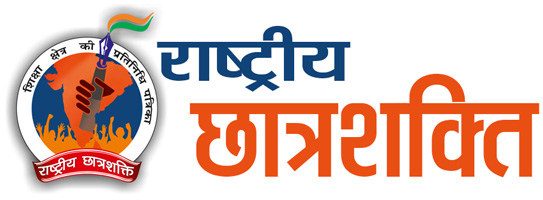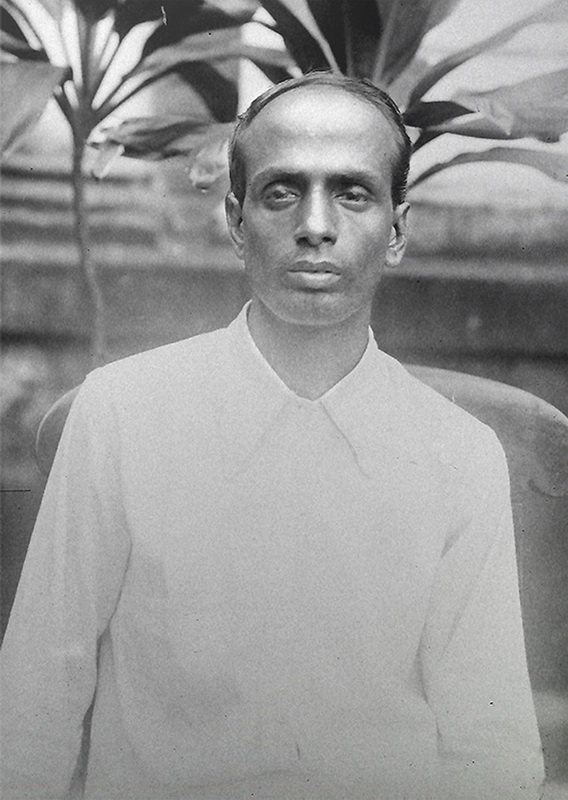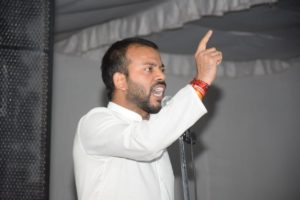“Who knew that the tranquil and calm eyes that used to be immersed in knowing the inner soul of that innocent teacher would someday sparkle in to take revenge against the two hundred years long oppression his mother land suffered? Revenge against the barbaric inhuman torture to suppress 1857’s mutiny, revenge against brutal massacre of Jalianwala bagh! Who knew that the person with lean hands and even leaner and emaciated legs would dismantle and ridicule the arrangements and power of the imperialist British government and would ignite the fire of revolution in villages of Chattagram from years to years?”
~ Translated from the book AgnigarbhaChattagram (The Fiery Chattagram) by Ananta Singha (A fellow revolutionary of Surya Sen)1.
The auspicious land of then undivided Bengal has given birth to numerous brave freedom fighters and martyrs. A report of Rajya Sabha describes over 300 freedom fighters from Bengal alone were sent to cellular jail2. Out such many brave hearts, Surya Sen (Surya Kumar Sen), commonly called as Masterda, is someone special to mention as his revolutionary activity destabilised British Empire from its very own root. He was born to a financially backward parents of Rajmani Sen (father) and Shashibala Sen (mother) on 22nd March, 1894 in Raujan sub-district of Chattagram. He was brought up by his uncle Gouramani Sen as he lost his parents in early childhood3. He obtained his graduate degree in mathematics from Krishnanath College, Baharampur, Murshidabad4. During this time, he developed close contacts with the revolutionary organisation “Jugantar” in Bengal and was motived in revolutionary activities5. He then joined as a mathematics teacher in Umatara English High School, Chattagram, as a mathematics teacher in 1917. This gave him the popular title Master Da (Da in bengali is used for a senior person)6.
Out of many great nationalistic deeds of Surya Sen, few outstanding revolutionary activities include Nagarkhana Hills War, Jalalabad British Armoury Raid and European Club attack. He was also a pioneering person in involving women revolutionaries as it was not allowed earlier8. Master da Surya Sen joined non- cooperation movement in 1920 and stayed away from revolutionary activities in Mahatma Gandhi’s request. As the movement ended, revolutionary activities started to begin again. On 23rd December, 1923, Master Da and the members of his secret revolutionary team raided British Treasury to fund revolutionary movement. A few weeks later, the british police raided their place and an armed conflict took place, that is commonly known as “Nagarkhana Hill War”9. Master da and his associate Ambika Chaktabarty got released from custody as barrister “Deshapriya” Jatindra Mohan Sengupta fought for him and his associates10.
The revolutionaries once released, planned to assassinate British Police Commissioner of Kolkata, Tegart, as he was infamous for torture on revolutionaries. Once police came to know about this, the revolutionaries like Ganesh Ghosh, Nirmal Sen, Ambika Chakrabarty, Ananta Singha, were further arrested on 25th October, 1924. Master Da, although stayed away from being arrested, was ultimately arrested in 8th October, 1926 and was sent to Medinipur central jail and later to Ratnagiri Jail, Bombay and Belgaon Jail. He got released at the end of 192811. From 1930 onwards Surya Sen started reconstructing armed revolutionary movement again by being inspired by the revolutionary activities of Irish Republican Army and formed “Indian Republican Army, Chittagong Branch” 13.
The British Armoury Raid:
The most heroic deed of Master Da Surya Sen was obviously the British Armoury Raid and declaring Chattagram as an independent territory. On 18th April, 1930, the revolutionaries cut the railway services connecting Chattagram to rest of the India, and dismantled the telegraph service. They raided the British Armoury and occupied Dampara Police reserve and hoisted national flag there14. Masterda Surya Sen declared Chattagram as an independent territory and declared the formation of temporary revolutionary government. In his speech he said,
“The great task of revolution in India has fallen on the Indian Republican Army. We in Chittagong have the honour to achieve this patriotic task of revolution for fulfilling the aspiration and urge of our nation. It is a matter of great glory that today our forces have seized the strongholds of Government in Chittagong…The oppressive foreign Government has closed to exist. The National Flag is flying high. It is our duty to defend it with our life and blood”15.
Chattagram remained independent for four days but the revolutionaries suffered from strong food scarcity. In between the British police declared a token prize of five thousand rupees for Master da Surya Sen and six other revolutionaries. The British police attacked the revolutionaries while they were staying in Jalabad Hills and in this war almost 70 British soldiers died and twelve revolutionaries were martyred. They were Naresh Roy, Tripura Sengupa, Bidhubhushan Bhattacharyya, Harigopal Bal, Matilal Kanungo, Prabhas Chandra Bal, Shashanka Sekhar Dutta, Nirmal Lala, Jiten Dasgupta, Madhusudan Dutta, Pulin Chandra Ghosh and ArdhenduDastidar, Apurba Sen, Jiban Ghoshal16. Most of the revolutionaries were arrested including Ananta Singha, Ambika Chakrabarty, Loknath Bal and Ganesh Ghosh. Ambika Chakrabarty was given death penalty and later life long imprisonment and rest of them were sent to Andaman Cellular Jail for life17,18.
The British police tried to capture Master Da and rest of his associates but they failed to do so. On13th June,1933, Surya Sen, PritilataWaddedar and Kalpana Datta could flee by shooting British captain Cameron but their associate Nirmal Sen was shot dead19.
The European Club Attack:
Along with the armoury raid, the revolutionaries also planned to attack the European club where “Natives and dogs were not allowed to enter”. But since 18th April, 1930 was Good Friday the plan was shifted to 23rd September, 1932. PritilataWaddedar, a woman revolutionary of the organisation was given the charge to execute the operation. About this operation, Master Da writes,
” Now there is no shortage of brave youths in Bengal. From Baleshwar to Jalalabad to Kalarpot, the soil of this nation has become wet repeatedly by the blood of these brave young men. But now, the bravery of women has always been unwritten in history. I want the formation of this chapter by the sacrifice of women. Let the British and the world know that even our women are not lagging behind in revolutionary activities.”20
On 23rd September almost fifty British persons were shot dead under the leadership of Pritilata. She was also injured but she chose death over brutal physical torture in custody and took potassium cyanide, a strong poison and was martyred21.
Arrest and death penalty:
The British government was desperate in arresting Master da Surya Sen under any circumstances and due to some traitors, they were successful in arresting him and his associates on 16th February, 1933. On 14th August, 1933 he was given death penalty although the British police couldn’t produce enough evidence other that carrying arms22.
His last message to another fellow revolutionary Kalikinkar Dey was “My last message is ideology and unity…write the names of the freedom fighters who sacrificed their life for India’s independence in the deeper to deepest core of your heart with blood”. He reminded his dreams of independent India, free India, for which he has fought throughout his life.
The death penalty of Masterda Surya Sen and his fellow revolutionary Tarakeshwar Dastidar was executed on 12th January, 1934. Master da Surya Sen and Tarakeshwar Dastidar were brutally beaten with hammer in their heads. Their bones and teeth were broken with hammer by British police. And their eyes and nails were uprooted. After such inhuman brutal torture, the bodies of both revolutionaries were hanged till death. The dead bodies were not handed over to their families for last rituals, rather the dead bodies of those two brave sons of Bharat Mata were tied with iron bars and were thrown at the junction of Bay of Bengal and Indian ocean23.
The struggle of independence was not a smooth event. Thousands of brave sons and daughters of this pious land had sacrificed their lives to bring the independence. The post independent India had hardly appreciated their bravery. Such majorly unappreciated brave revolutionaries have been limited to text books, names of roads and railway stations or statues. The overall scenario of today’s corruption, rapes, murders, inequality, injustice, illiteracy, narrowness, opportunists, malnutrition, inhumanity were not something those brave hearts dreamt of. The charm and dream that moved them to jump in the war, knowing the end results are somewhat missing in today’s scenario. The dreams of Masterda Surya Sen and his associates if materialised, the nation will be heaven in earth. The tri colour would fly high in the sky where the earthly vices can never reach.
References:
- প্রথমখন্ড, অনন্তসিংহ।অগ্নিগর্ভচট্টগ্রাম।কলকাতা: বিদ্যোদয়লাইব্রেরি।পৃষ্ঠা৭।
(AgnigarbhaChattagram (Fiery chattagram), First edition, Kolkata, Vidyodyaya library, page 7)
- Annexure reffered to in reply to part (a) to (c) of RajyaSabha, unstatred question number 1756 for 9.7.2019
- পাল, রুপময় (১৯৮৬)।সূর্যসেনেরসোনালিস্বপ্ন।কলকাতা: দীপায়ন।পৃষ্ঠা৪৩।
(Pal, Rupamay (1986); SurjaSenerSonali Swapna(The golden dreams of Surya Sen); kolkata, Dipayan, page 43)
- সৌমেন্দ্রকুমারগুপ্ত, সূর্যসেনওস্বাধীনতাসংগ্রাম (১৯৯৫)।বহরমপুরেমাস্টারদা: কিছুজিজ্ঞাসা।বহরমপুর: সূর্যসেনাপ্রকাশনী।পৃষ্ঠা৪৪।
(Soumendra Kumar Gupta; Surja Sen o Swadhinata Sangram (1995) (Surya Sen and Independence Movement); Baharampuremasterda: kichujiggasa (Masterda in Baharampur: some questions) SurjasenaPrakashani; page 44)
- DO AND DIE: The Chittagong Uprising: 1930-34, Manini Chatterjee, Page 23, 1999, Penguin Books, India
- পূর্নেন্দুদস্তিদার (১৯৬৭)।স্বাধীনতাসংগ্রামেচট্টগ্রাম।চট্টগ্রাম: বইঘর।পৃষ্ঠা২২, ৫১, ৭৩। (PurnenduDastidar (1967); Swadhinatasangramechattagram; Chattagram, Boighar, page 22, 51, 73)
- Chakrabarti, Bidyut (1990). Subhas Chandra Bose and Middle-Class Radicalism: A Study in Indian Nationalism, 1928-1940. I. B. Tauris & Co. Ltd. p. 108. ISBN 1850431493.
- পূর্ণেন্দুদস্তিদার (২০০৯)।স্বাধীনতাসংগ্রামেচট্টগ্রাম।ঢাকা: অনুপমপ্রকাশনী।পৃষ্ঠা৬৯। (PurnenduDastidar (1967); Swadhinatasangramechattagram; Chattagram, Boighar, page 69)
- পূর্ণেন্দুদস্তিদার (২০০৯)।স্বাধীনতাসংগ্রামেচট্টগ্রাম।ঢাকা: অনুপমপ্রকাশনী।পৃষ্ঠা৫০–৫১। (PurnenduDastidar (1967); Swadhinatasangramechattagram; Chattagram, Boighar, page 50,51)
- পূর্ণেন্দুদস্তিদার (২০০৯)।স্বাধীনতাসংগ্রামেচট্টগ্রাম।ঢাকা: অনুপমপ্রকাশনী।পৃষ্ঠা৫৭। (PurnenduDastidar (1967); Swadhinatasangramechattagram; Chattagram, Boighar, page 57)
- পাল, রুপময় (১৯৮৬)।সূর্যসেনেরসোনালিস্বপ্ন।কলকাতা: দীপায়ন।পৃষ্ঠা ৬২, ৬৫,৬৭।(Pal, Rupamay (1986); SurjaSenerSonali Swapna(The golden dreams of Surya Sen); kolkata, Dipayan, page 62, 65, 67)
- THE CHITTAGONG REVOLT 1930-34, Dr.Suniti Bhushan Qanungo, Page 30, 1994, Kanungopara, Chittagong
- DO AND DIE: The Chittagong Uprising: 1930-34, Manini Chatterjee, Page 60, 1999, Penguin Books, India
- শতবর্ষেরসন্তবিপ্লবীবিনোদবিহারীচৌধুরী, অলকানন্দিতা, পৃ৩৪, ২০১০, বাতিঘর, চট্টগ্রাম (Shotoborshersontobiplobi Binod Bihari Choudhury; Alaka Nandita; page 34; (2010), Batighar, Chattagram)
- THE CHITTAGONG REVOLT 1930-34, Dr.Suniti Bhushan Qanungo, Appendix IV, 1994, Kanungopara, Chittagong
- ত্রৈলোক্যনাথচক্রবর্তী, জেলেত্রিশবছর, ধ্রপদসাহিত্যাঙ্গন, ঢাকা, ঢাকাবইমেলা২০০৪,পৃষ্ঠা১৯৪-১৯৫। (Troilokya Nath Chakrabarty; Jele Trish Bochor (Thirty years in Jail); Dhrupad Sahityangan; Dhaka; Dhaka Book fair; (2004); pages 194, 195)
- পাল, রুপময় (১৯৮৬)।সূর্যসেনেরসোনালিস্বপ্ন।কলকাতা: দীপায়ন।পৃষ্ঠা১৮৭।(Pal, Rupamay (1986); SurjaSenerSonali Swapna(The golden dreams of Surya Sen); kolkata, Dipayan, page 187)
- পূর্ণেন্দুদস্তিদার (২০০৯)।স্বাধীনতাসংগ্রামেচট্টগ্রাম।ঢাকা: অনুপমপ্রকাশনী।পৃষ্ঠা১৮৩।(PurnenduDastidar (1967); Swadhinatasangramechattagram; Chattagram, Boighar, page 183)
- THE CHITTAGONG REVOLT 1930-34, Dr.Suniti Bhushan Qanungo, Page 78, 1994, Kanungopara, Chittagong
- পূর্ণেন্দুদস্তিদার (২০০৯)।স্বাধীনতাসংগ্রামেচট্টগ্রাম।ঢাকা: অনুপমপ্রকাশনী।পৃষ্ঠা১৭১। (PurnenduDastidar (1967); Swadhinatasangramechattagram; Chattagram, Boighar, page 171)
- THE CHITTAGONG REVOLT 1930-34, Dr.Suniti Bhushan Qanungo, Page 80, 1994, Kanungopara, Chittagong
- THE CHITTAGONG REVOLT 1930-34, Dr.Suniti Bhushan Qanungo, Page 82, 1994, Kanungopara, Chittagong
- DO AND DIE: The Chittagong Uprising: 1930-34, Manini Chatterjee, Page 261, 1999, Penguin Books, India







